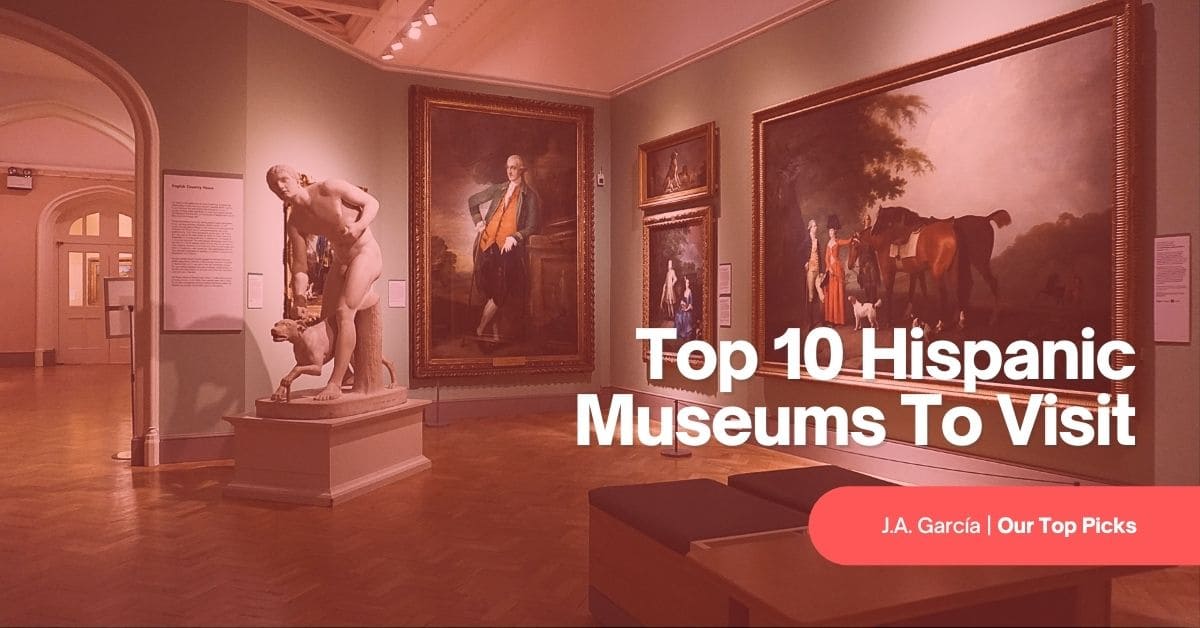
Top 10 Hispanic Museums to Visit
Let’s discover great Hispanic museums together!
Visiting museums is one of the best activities to delve into specific topics and learn about history in a fun way.
Keep reading and discover some of the best Hispanic museums you can visit in the United States and beyond.
Join 559 million people on the planet who speak Spanish!
Sign up for your free trial Spanish class today.

The Significance of Hispanic Culture Museums
At some point in our lives, we have all visited a museum either on a school field trip or with our family.
Approximately 850 million people visit museums every year in the United States and learn about some new topic in world history.
Museums play an important role in our society as they preserve history and tell us stories about our country, communities, and cultures.
That is why museums dedicated to the Hispanic community are important.
Latino museums or Hispanic museums exist to educate all generations and nationalities about Latin American and Hispanic culture.
At these places, children and families will learn about how Hispanic culture has transformed the United States.
Also, you can learn details of people’s lifestyles, such as the powerful role of the family in Hispanic culture as opposed to the U.S. culture.
It is vital that these spaces exist where Hispanic children can learn about the origin of their family, migration to the United States, and the fight for equal rights.
In addition, the Latino and Hispanic population continues to increase in the United States, so these museums will continue to grow with the desire to preserve their art, culture and celebrate their history.
10 Hispanic Museums Worldwide
In this article, you will find a list of 10 Hispanic museums where you can learn about the history of Latin American and Hispanic people.
Due to migration in Latin America, most museums dedicated to its history are found on the American continent; however, we have included some from Europe.
Let’s begin!
1. El Museo del Barrio – Manhattan, New York. U.S.
El Museo del Barrio is one of the many Spanish museums in NYC.
It was founded in 1969 to show and preserve the art and culture of Puerto Ricans and Latin Americans in the United States.
The exhibits are the main attraction, but the Museum also has bilingual public programs, educational activities, festivals, and special events.
The importance of this museum is that it allows visitors to enhance the sense of identity, self-esteem, and self-knowledge of Caribbean and Latin American peoples.
The Museum has a permanent collection of more than 8,500 objects that covers more than 800 years of Latin American and Caribbean art.
From pre-Columbian to modern and contemporary art, the collection focuses on three main cultures divided into categories such as urban experiences, graphics, craft, women artists, and Latinx, among others.
2. Museum of Latin American Art – Long Beach, California. U.S.
This Museum’s mission is to expand knowledge and appreciation of modern and contemporary Latin American art through its collections and activities.
The MOLAA (Museum of Latin American Art) was founded in 1996 and is the only Museum in the U.S. dedicated to recent Latin American art.
Its facilities exhibit pieces by artists from Latin American countries who are recognized in their lands but not in the United States. Its permanent collection has over 1,300 pieces of art.
They also have stimulating educational programs such as school tours and workshop programs, virtual guided tours, bilingual arts and culture summer camps, teacher resources, etc.
And you can attend any of their events to immerse yourself even more in Latino culture through music, storytellers, student exhibitions, and parties.
3. Instituto de Cultura Hispánica – Corpus Christi, Texas. U.S.
The purpose of this Museum is to promote a better understanding of the diverse cultures represented in the Hispanic community.
As part of the initiatives to fulfill its mission, the Instituto de Cultura Hispánica organizes exhibitions, folkloric displays, English and Spanish recitals, cultural celebrations, etc.
This organization, created in 1976, gives South Texas citizens who share an interest in promoting Hispanic culture a riveting platform.
This organization works hard to increase cultural exchange between Texans and the entire country.
This cultural approach contributes to Americans better appreciating Hispanic art, literature, folklore, food, and traditions.
The Museum includes a permanent display of folk clothing, art, and artifacts from different Hispanic countries. Also, they periodically have a special featured exhibit.
4. El Museo Latino – South Omaha, Nebraska. U.S.
The Latino Museum is a non-profit organization located in Omaha, Nebraska, and its mission is to collect, exhibit, and interpret the Latino art of the Greater Omaha Area.
Through direct support of local artists, the Museum is committed to strengthening creative and artistic culture by increasing the visibility of Latino art.
The Museum has permanent and special exhibits where visitors can explore the work of Latino artists from pre-Columbian to contemporary times.
In addition, it offers annual cultural programs in visual and performing art for children, teens, and adults, as well as events, workshops, and classes with specific themes.
The permanent and special exhibitions are unique since they have new or unpublished material by famous artists made in their countries but who are unknown in the US.
The Latino Museum is known for its annual Cinco de Mayo celebration, which brings together the entire Hispanic community of Omaha.
5. Museo Nacional de Antropología – Mexico City, Mexico
For lovers of Mesoamerican culture, this Museum is a jewel that shouldn’t be missed.
Located in the heart of Mexico City, the MNA (Museo Nacional de Antropología) is a home for Mexico’s indigenous heritage.
For more than five decades, they have been dedicated to researching, conserving, exhibiting, and disseminating the archeology and ethnography of Mexico.
The museum includes 22 rooms with more than 45,000 square meters of construction, making it the largest Museum in the country and one of the most outstanding in the world.
Its cultural importance is to be more than a repository, but rather a space for reflection on the rich indigenous heritage of a multicultural country like Mexico.
It pays homage to indigenous peoples through a permanent exhibition full of representations, expressions, knowledge, and traditions that are a legacy for humanity.
6. Museo Nacional de Bellas Artes de Cuba – La Habana, Cuba
The creation of this space, located in Havana, Cuba, is to preserve, investigate and exhibit the collections to disseminate knowledge to all the people who visit them.
The Museum has different areas in charge of collections, restoration, educational services, cultural events, and research and scientific documents publications.
Its permanent collection is divided into two large areas: Cuban art and universal art. The Cuban art collection has over 30 thousand pieces from the 17th century to the present.
The universal collection is divided into areas according to the continent or country.
To fulfill its objectives of disseminating Cuban art, gastronomic, and artistic, educational activities are carried out to support the local artist and publicize more contemporary pieces.
7. Museo Larco – Lima, Perú
This Museum was founded in 1926 and is the most prominent place where the history of ancient Peru is collected.
The permanent exhibition brings us closer to the Andean worldview and helps visitors understand how pre-Columbian societies developed.
The Larco Museum is one of the few museums in the world with storage warehouses where pieces not available to the public are kept. Still, permission can be requested to enter and admire the repository. So, don’t be afraid to talk to a representative!
The pre-Columbian art collection has approximately 45,000 archaeological pieces that from across 5,000 years of the history of ancient Peru and the relationship locals had with nature.
8. Museo de Arte Latinoamericano de Buenos Aires – Argentina
This private Museum is dedicated exclusively to Latin American art from the early 20th century to the present.
The permanent collection has approximately 600 works by the greatest Latin American artists such as Frida Kahlo, Fernando Botero, Antonio Berni, etc.
The exhibition is divided into four: Latin American avant-garde from the 20s, paintings from the 30s and 40s that reflect the region’s political history, an exhibition on abstract trends, and the last one is about contemporary art from the 60s and 70s.
It has an agenda of cultural events, workshops, and seminars on different branches of art. The Museum is among the richest in Argentine and Latin American art formation.
It also has educational spaces for children, where they can learn by painting and making comics to spaces and can even join debates with other family members.
9. Museo Ralli Marbella – España
The Ralli Marbella Museum should be a must on your trip if you are close to Spain.
This Museum opened in 2000 and has one of Europe’s most important collections of Latin American art.
Its objective is to disseminate contemporary Latin American and European art.
Their collection has works by artists such as Wilfredo Lam from Cuba, Leopoldo Torres Agüero from Argentina, Herman Braun-Vega from Peru, Salvador Dalí from Spain, etc.
When selecting art for their permanent or temporary collections, curators choose works for their artistic quality rather than focusing on how famous the authors are.
This gives a wide opportunity to Latino artists in Spain or Europe, or even in their native countries, to show their art without going through rigorous selection processes.
10. Museo Nacional Centro de Arte Reina Sofía – Madrid, España
This Spanish Museum has the best modern art in Spain.
The collection reflects historical and socio-economic events from the 20th century to the present.
The Museum, inaugurated in 1990, was created to preserve, increase, and show Spanish artistic pieces to promote knowledge of contemporary art in its various manifestations.
It is home to one of the most important paintings and representatives of modern Spanish history, Picasso’s Guernica.
Because Spain has close relations with Latin America, there is extensive collaboration with museums and curators in the region, which allows the creation of important exhibitions of contemporary Latin American art.
We recommend: The ‘Vulgar’ History and Origin of the Spanish Language
Tips for Planning Museum Visits
Now that you know some of the most essential Hispanic museums, it’s time to plan your visit!
For your trip and the museum tour you choose to be a relaxed and fun experience, it is crucial to consider some basic recommendations.
Buy your tickets in advance. Most museums offer the option of buying tickets online to save you the long waiting lines.
This is also important as some museums have changed their policies and limit the number of people that can enter by hours.
Check the Museum’s website to verify exhibition dates for temporary exhibits. If your visit date is flexible, we recommend you check if there is an exciting exhibition you’d like to see.
Check the hours of operation and the days it is open, since museums are usually closed on Mondays and Tuesdays.
Also, some museums, mostly public ones, allow free admission monthly or weekly.
Visiting a museum can take a few hours per day, so we recommend you choose to see at least two a day, and you must include breaks for snacks and lunch.
And finally, remember that the weather can vary throughout the year, so museums are the best indoor activity if you visit the city in the rainy season.
Visit Hispanic Museums and Practice Your Spanish!
One of the advantages of visiting Latin American museums is that you can appreciate the rich heritage and diverse artistic expressions of Hispanic culture and practice your Spanish.
And this is not only for adults. Children and teenagers can also enjoy a day at the Museum and learn new vocabulary and expressions in Spanish about Latino history.
If visiting Latino museums has aroused a fascination for culture and language in you, we recommend that you start a new adventure by learning the Spanish language.
At Homeschool Spanish Academy, we have expert-certified curriculum teachers from Guatemala ready to help in this journey.
Learn the language through innovative, human-centered learning strategies from your first class. Sign up for a free trial class!
We’ve been teaching Spanish for over 10 years, so click here to check our prices and programs available for all ages.
We’re here to support you!

Join one of the 40,000 classes that we teach each month and you can experience results like these

“This is the best way for your kid to learn Spanish. It’s one-on-one, taught by native Spanish speakers, and uses a curriculum.”
– Sharon K, Parent of 3

“It’s a great way to learn Spanish, from native Spanish speakers in a 1-on-1 environment. It’s been fairly easy to schedule classes around my daughter’s other classes. The best value for us has been ordering multiple classes at a time. All the instructors have been great!”
– Cindy D, Parent of 3

“HSA offers very affordable, quality, one on one classes with a native speaker. My son has greatly benefited from taking classes. We have seen his confidence increase as well as his pronunciation improve because he learns from a native Spanish speaker. HSA has quick, personal customer service. Our family has been very pleased with our experience so far!”
– Erica P. Parent of 1
Want to learn more about Hispanic and Latin American culture? Check these out!
- French vs Spanish: 7 Reasons Spanish Could Be a Strong Long-Term Investment
- 7 Creative Ways to Maintain Spanish Fluency at Home — Perfect for Elementary Kids
- The Best Spanish Learning Podcasts for Kids
- Raising a Bilingual Child: 10 Must-Have Resources Every Parent Needs
- 5 Proven Strategies to Help Your Middle Schooler Excel in 1-on-1 Online Spanish Classes
- 10 Expert Tips to Keep Your Middle Schooler Motivated in Online Language Lessons
- 5 Fun & Easy Spanish Activities to Do at Home with Your Preschooler
- The Best Spanish Learning Apps, Books, and Games for Kids
- What Does it Actually Take to Become Fluent in Spanish? - August 29, 2024
- Learn About Hispanic History: Were Hispanics Slaves? - May 30, 2024
- Turn Your Life Around: From Passive Bilingualism to Fluency! - April 4, 2024






